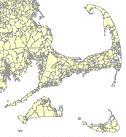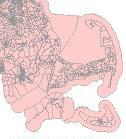Downloads
.zip file containing:
statewide ESRI Shapefile (census2000blockgroups_poly.* | census2000blockgroups_poly_orig.*)
Attributes
The polygon attributes (census2000blockgroups_poly.dbf and census2000blockgroups_poly_orig.dbf) for the Census 2000 Block Groups shapefiles distributed by MassGIS contain the following items:
| ITEM NAME | TYPE / WIDTH | DESCRIPTION |
|---|---|---|
| AREA | N / 20 | Area of polygon(s) in square meters. |
| PERIMETER | N / 20 | Perimeter of polygon(s) in meters. |
| STATE | C / 2 | State ID Code. (Massachusetts = 25) |
| COUNTY | C / 3 | County code (FIPS-ID without “25”) |
| TRACT | C / 6 | Census 2000 Tract Code |
| BLOCKGROUP | C / 1 | Census 2000 Blockgroup Code |
| BG_ID | C / 20 | Unique Blockgroup ID value |
| CT_ID | C / 20 | Unique Census Tract ID value |
| BLK_COUNT | N / 3 | Number of blocks in the blockgroup |
| LOGRECNO | C / 7 | Common field to join/link to related attribute tables |
| TOTAL_POP | N / 10 | 100% Count of Population (from SF1) |
| SAMP_POP | N / 10 | Sampled Count of Population (from SF3) |
| DRY_PCT | N / 8 | Percentage of non-water area for the block |
| DRY_ACRES | N / 12 | Non-water area, in Acres |
| DRY_SQMI | N / 10 | Non-water area, in Square Miles |
| DRY_SQKM | N / 10 | Non-water area, in Square Kilometers |
| ** - For the most accurate display of population density by Block Group, normalize TOTAL_POP by any of the last three items. | ||
| Note: The 100% population counts and the sampled population counts for any given census block group will often have different values. This is due to the nature of sampling and extrapolation techniques in statistics. It is recommended that when using SF1-derived data, the 100% population count be used, whereas when SF3-derived data is used, the sampled population should be utilized instead in order to maintain consistency between the headcount and the tabular values. | ||
Related demographics tables
The following tables, extracted from the SF3 tables and available in dBase format (.dbf), which provide detailed demographics information, may be joined to the Block Groups shapefiles on the LOGRECNO item. See the Field Descriptions at bg_fields.xls (Excel format) and bg_fields.dbf (dBase format).
(plus field description table, in a zip file; 6.3 MB) or click the Download link after each table description to download that table in a zip file
education_attainment_by_gender_age.dbf (SDE name: GISDATA.CEN2K_BG_ED_ATTAIN_GEN_AGE)
Lists the breakdown of all individuals age 25 and over by gender and highest level of schooling. Download educational attainment by gender age
education_enrollment_by_gender_age.dbf (SDE name: GISDATA.CEN2K_BG_ED_ENROLL_GEN_AGE)
Lists the breakdown of all individuals age 3 and over by gender and which enrollment category (groupings of grades) they fall within, as well as private vs. public school distinctions. Download education enrollment by gender age
employment_status_by_gender.dbf (SDE name: GISDATA.CEN2K_BG_EMP_STAT_GEN)
Lists the breakdown of all individuals age 16 and over by gender and their status in the labor force. Download employment status by gender
household_language_spoken.dbf (SDE name: GISDATA.CEN2K_BG_HH_LANG_SPOK)
Displays number of households for each primary base language type spoken at home. Distinguishes between isolated vs. non-isolated language skills. Download household language spoken
household_size_by_family.dbf (SDE name: GISDATA.CEN2K_BG_HH_SIZE_FAM)
Breakdown of number of households by family vs. non-family status, and number of individuals in the household. Download household size by family
households_by_age_family_children.dbf (SDE name: GISDATA.CEN2K_BG_HH_AGE_FAM_CHILD)
Shows number of households broken down by age of primary household owner, family vs. non-family household, marital status, and presence or non-presence of children. Download households by age family children
housing_amenities_by_tenure.dbf (SDE name: GISDATA.CEN2K_BG_HOUSING_AMEN_TEN)
Details how many housing units use certain primary sources of fuel, number of vehicles owned by occupants (renters vs. owners), and number of units with complete plumbing and kitchen facilities. Download housing amenities by tenure
housing_owner_rental_demographics.dbf (SDE name: GISDATA.CEN2K_BG_HS_OWN_RENT_DEMO)
Shows number of housing units broken down by owner vs. renter, racial category, age of owners and/or renters, number of persons living in housing units, and occupants per room statistics. Download housing owner rental demographics
housing_rent_statistics.dbf (SDE name: GISDATA.CEN2K_BG_HOUS_RENT_STATS)
Lists number of rented housing units within categories specifying amount of rent paid, whether this is contract rent vs. gross rent vs. requested rent (for vacant units), and the amount of rent paid dependent upon number of bedrooms in the unit. Also lists number of rented housing units with respect to percentage of income allocated for rent. Download housing rent statistics
housing_residency_characteristics.dbf (SDE name: GISDATA.CEN2K_BG_HOUS_RES_CHAR)
Provides true-count and sampled numbers of housing units, owner vs. renter occupied, occupied vs. vacant, racial profiles of house owners, and number of persons in occupied housing units. Download housing residency characteristics
housing_rooms.dbf (SDE name: GISDATA.CEN2K_BG_HOUSING_ROOMS)
Breakdown of number of rooms in all housing units, as well as owner-occupied vs. renter-occupied housing units. Median and aggregate numbers of rooms included. Download housing rooms
housing_structure_age.dbf (SDE name: GISDATA.CEN2K_BG_HOUS_STRUCT_AGE)
Lists number of housing units built within a given time period. Also lists the median year that all housing units within a given blockgroup were built. Download housing units
housing_units.dbf (SDE name: GISDATA.CEN2K_BG_HOUSING_UNITS)
Provides numbers of housing units, broken down by occupied vs. non-occupied, owner-occupied vs. renter-occupied, and the number of units in each house. Download housing units
housing_value.dbf (SDE name: GISDATA.CEN2K_BG_HOUSING_VALUE)
Shows number of owner-occupied housing units that fall within incremental housing value categories. Includes median housing values. Download housing value
income_by_familytype.dbf (SDE name: GISDATA.CEN2K_BG_INC_FAMTYPE)
Number of families vs. non-families that fall within incremental income categories, as well as median income, aggregate income, and aggregate income of wealthy vs. non-wealthy families. Also includes per capita income. Download income by family type
income_by_household.dbf (SDE name: GISDATA.CEN2K_BG_INCOME_HH)
Lists number of households falling within incremental income categories, as well as median income, aggregate income, and aggregate income of wealthy vs. non-wealthy households. Download income by household
income_poverty_levels_by_age.dbf (SDE name: GISDATA.CEN2K_BG_INC_POV_LEV_AGE)
Using census definition of poverty based on income, shows how many individuals do and don't meet the federal criteria for "poor" and which age grouping they fall into. Download income poverty levels by age
population_by_age_gender.dbf (SDE name: GISDATA.CEN2K_BG_POP_AGE_GEN)
Lists how many members of each gender fall within incremental age categories. Download population by age gender
population_by_race.dbf (SDE name: GISDATA.CEN2K_BG_POP_RACE)
Racial breakdown of population. Distinguishes between 7 major categories and their hispanic vs. non-hispanic counterparts. Download population by race
transportation_commute_means.dbf (SDE name: GISDATA.CEN2K_BG_TRNS_COM_MEANS)
Provides breakdown of number of employed individuals and their various methods of transportation commuting to work. Download transportation commute means
transportation_commute_time.dbf (SDE name: GISDATA.CEN2K_BG_TRNS_COM_TIME)
Commuting to work travel times for the employed non-work-at-home population. Broken into time intervals and reflects mode of transportation. Also lists non-commuting population. Download transportation commute time

